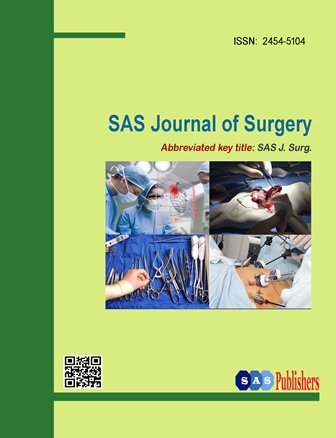+91-9365665504
+91-8724002629
submit@saspublishers.com / saspjournals@gmail.com

An International Publisher for Academic and Scientific Journals
Author Login
SAS Journal of Surgery
Journal Home
Description
Editorial Board
Archives
Indexing
Statistics
Title : SAS Journal of Surgery
Abbr : SAS J Surg
ISSN (Online) : 2454-5104
ISSN (Print) : Open Access
Discipline : Surgery
Frequency : Monthly
Country : India
Language : English
Abbr : SAS J Surg
ISSN (Online) : 2454-5104
ISSN (Print) : Open Access
Discipline : Surgery
Frequency : Monthly
Country : India
Language : English
10.36347/sasjs
DOI
DOI
4.0
IMPACT FACTOR
IMPACT FACTOR
Current Issue : Volume-11 - Issue-12 ; 2025
Recently Published Articles
Dec. 23, 2025 | Original Research Article
Prospective Analysis of Uroflowmetric Changes after Transurethral Resection of the Prostate (TURP)
Manish Acharya, Ijan Dhamala, Soniya Bhatta, Kuldip Sapkota, Dipak Mishra, Sashi Tandan, Ashish Mishra, Manish K. Sah, Jitendra Gupta, Bibek Poudel Kshetri, Nayana S Kumar
SAS J Surg | 1130-1137
DOI : https://doi.org/10.36347/sasjs.2025.v11i12.013
Dec. 20, 2025 | Original Research Article
Assessment of Patient Satisfaction after Laparoscopic Cholecystectomy at the Brazzaville University Hospital Center
Elion Ossibi Pierlesky, Note Madzele Murielle Etiennette Julie, Massamba Miabaou Didace, Bhodeho Monwongui Medi, Tsouassa Wa Ngono Giresse Bienvenu, Avala Prude Pertinie, Motoula Latou Noé Henschel
SAS J Surg | 1126-1129
DOI : https://doi.org/10.36347/sasjs.2025.v11i12.012
Dec. 15, 2025 | Case Report
Emergency Tirone David Procedure in a Marfanoid Patient with Extensive Aortic Dissection and Severe Aortic Regurgitation: A Case Report
Hatim YOUSFI , Amine ALLAM, Marwane OUHADI, Anass KHAMLICHI, Siham BELLOUIZE, Fouad NYA, Anis SEGHROUCHNI, Rachida SAOUAB, Younes MOUTAKIALLAH
SAS J Surg | 1122-1125
DOI : https://doi.org/10.36347/sasjs.2025.v11i12.011





